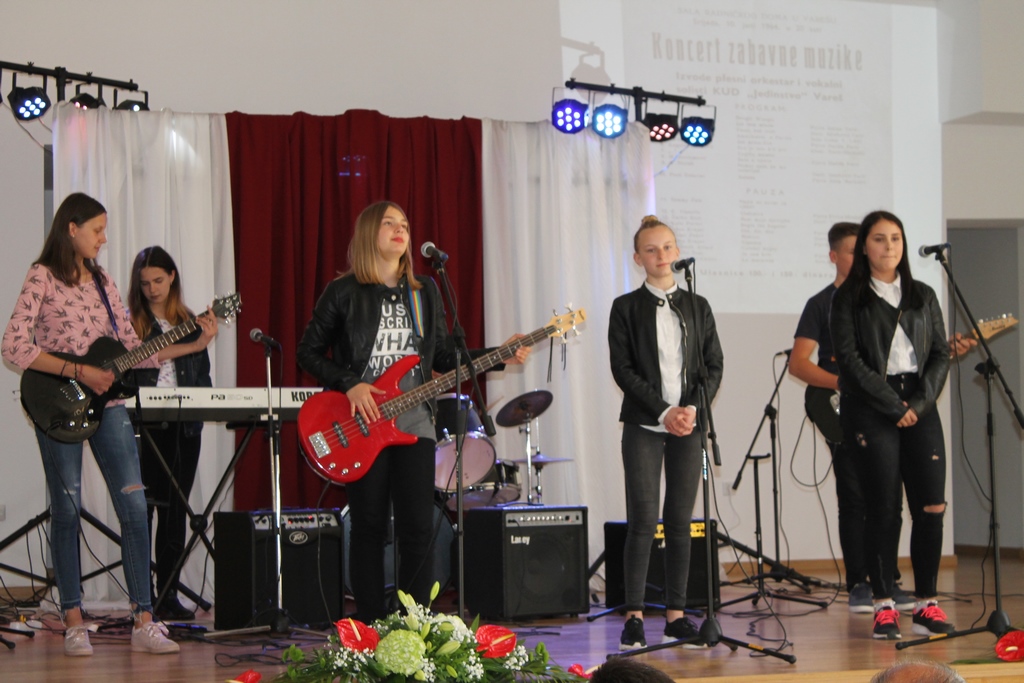Demolished in the most recent war and desolate ever since, the Vareš Community Centre, after a facelift, is now ready to welcome its music and drama company, with great plans for cultural events.
The Community Centre in Vareš stands rebuilt 25 years after being destroyed in the most recent war, its third one since it was built in 1904.
After three decades, nineteen-year-old graduate Benjamin Hinger’s generation is the first generation of seniors of the Vareš High School to have its senior prom in the restored Community Centre last week.
“We are all thrilled to have our senior prom in the Community Centre,” says Hinger, who believes that the events in his hometown would liven up now with the opening of the centre. “The Centre is nicely decorated. It is spacious, with plenty of capacities. It could house all sorts of events.”
Reconstruction of the Community Centre lasted several years after the war and has been supported by various funds, including funds from the Federation of BiH and the Government of the Republic of Croatia, while the final phase was funded by the European Union through Local Integrated Development project, implemented by the United Nations Development Programme (UNDP). Project activities also included preparation of the 2017-2026 Vareš Municipality Development Strategy.
Stjepan Šimić, acting director of the Public Institution Vareš Cultural Centre, as is now the formal name of the community centre, sincerely hopes that the venue would again be a meeting point for the youth and their “culture temple”, as it had been for generations of fellow citizens before them.
“We’ll strive to find what the tradition was and streamline towards contemporary currents,” says Šimić, adding that the next step is to kick-off the music and drama section, organise exhibitions, as well as to test out movie screenings.
Šimić’s generation was the last one to have their senior prom in the Community Centre before the war, but they continue to meet even nowadays.
“I do hope we could have one of our gatherings here as well. As the older ones come in, they are overwhelmed with emotions – this is where they had fun, where they gathered, met, fell in love. I doubt that anyone from Vareš could feel indifferent.”
An opportunity for new generations in Vareš
The Community Centre in Vareš was opened in 1904. From 1927 until the onset of the most recent war in BiH, it also housed the Cultural and Arts Society Jedinstvo. It had its own jazz orchestra, one of four in Yugoslavia, explains Šimić.
“Popular bands and singers would come here. Most certainly we were a more progressive community than some others in the surroundings. I hope this too would come back,” he says.
Vareš had the population of about 22,000 in early 1990s, but today it is less than 9,000. In the words of Nermin Librić, a former member of the tamburitza orchestra, and a high school professor of computer science today, the opening of the restored Community represents the revival of culture in his hometown.
“Older people remember the former Community Centre and activities it had offered, such as traditional dance, tamburitza orchestra, brass band, musical band. Some of these can surely be revived today in this town where the level of cultural events is quite low,” says Librić. “New generations still do not understand the significance until these activities are in place. We travelled extensively with the cultural centre; surely this is something that would be an additional motive for young people.”
Tears shed over the Community Centre’s facelift
Back in the 1960s, Emilija Zloušić performed at the Community Centre with the Cultural and Arts Society Jedinstvo. It is there that she met her late husband and celebrated important events in her life. Coming back to the restored hall of the Community Centre after 1991 brought her to tears.
“I’m very attached to this place,” she says, “I sang for years on this very stage. I joined the Cultural and Arts Society Jedinstvo in my freshman year in high school and sang popular melodies.”
Today, sixty-six-year-old Emily recalls that the centre was well-known beyond the borders of BiH. Friendships were made there, and first loves.
“It’s far more beautiful now, but memories are something else.”
She would like the Community Centre to be packed with young people, as it once was, and to start activities like the former one – pop orchestra, folk music orchestra, tamburitza or grand choir.
“It was wonderful here. This is where friendships were made, first loves, all the dancing and singing, the words fail me to describe all the beautiful things that had happened here. We had artists visiting from all over Yugoslavia. Further down from the centre, there was a great stage for concerts in the summer. And this stage here was something unforgettable for me. With all the excitement, I don’t even know how to tell everything that went on here,” she explains, adding that she would want new generations to have “at least a part of what we once had, to be out of the street, to restart some of the activities, as there are plenty of talented children in Vareš.”
Previously young rock bands did not have an adequate place to perform, high school students had no venue for proms, young married couples for their wedding receptions, the municipal hall was too small to accommodate major events – so, the new Community Centre brings back the venue for such social events.
Activities such as the opening of the Vareš Community Centre facilitate conditions for a better future for children and youth, which is one of the intervention areas of the Local Integrated Development (LID) project, aimed to improve living standards for more than 100,000 in BiH.
The project is a part of the EU’s Local Development and Employment Programme, funded by the European Union. In cooperation with local authorities, UNDP through LID works on establishing the mechanisms and resources needed for social and economic development. In addition to the renovation of the Community Centre, the project in Vareš has supported also employment in the textile industry, and assisted local authorities in improving their services and reducing administration costs, investing in infrastructure, and working on opening new jobs for socially vulnerable populations.





